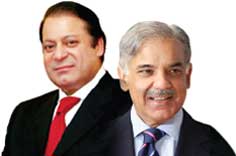Sustainable Economic Growth Performance 2013-2018
ECONOMY
Achieved resounding growth without inflation
- Maintained approximately 5% economic growth, reaching 5.79% in 2018
- Expanded the economy by more than 50% from Rs.22,385B to Rs. 34,396B
- Reduced budget deficit from 8.2% of the GDP in 2012-13 to 4.6% in2015-16
- Reduced average inflation to below 4%
Unleashed development
- Emerged as the 8th fastest growing nation in exports
- Increased industrial growth from 1.2% to 5.13%
- Enhanced development spending from Rs.1.3T to Rs.3T
- Increased BISP funding about threefold from Rs. 40B to Rs. 115B
- Grew large-scale manufacturing sector from 0.32% to 4.2%
- Increased growth in the services sector from 3.6% to 5.1%
- Increased companies incorporated per year from 3,900 to 8,500
- Increased foreign remittances from $13.9B to approximately $20B
- Doubled the capital invested in the Pakistan Stock Exchange
Attracted investments for infrastructure
- Initiated power and infrastructure projects with an investment of $223B in the last five years, as compared to $140B during 2008-13
- Launched game-changing CPEC projects with an investment of $60B
- Projects worth $30B have already been initiated
Improved efficiency of State owned Enterprises
- Set up 1,000 km of South North pipeline and established two ‘LNG regasification terminals in a record time through public sector gas companies
- Produced record profits in OGDC and PPL from oil exploration
- Liquidated shares of UBL, HBL and PPL to the private sector (with UBL and HBL rated as Best Equity Transactions in Asia for 2014 and 2015 respectively
Enhanced access to credit
- Enhanced average private sector credit from Rs. 96B to Rs. 457B
- Increased agriculture credit by 200%
- Developed National Financial Inclusion Strategy (NFIS) for the poor, and improved access to finance for micro, small and rural enterprises
- Enacted Credit Bureau Act and Secured Transaction Act to provide framework for establishment of a moveable assets collateral registry in order to enable SMEs to obtain credit against their moveable assets
Poverty Alleviation
Protected the Poor
- Expanded the BISP unconditional cash transfer program for women living under extreme poverty from approximately 3.2 million to 5.5 million households
- Increased the funding for BISP from Rs. 40 billion to Rs. 115 billion
- Provided comprehensive coverage against catastrophic illnesses to more than 3 million people across 44 districts living in abject poverty under the Prime Minister National Health Program
- Granted Rs. 2,000 per month to more than 90,000 people with disabilities under the ‘”Khidmat Card” program
Mainstreamed the Vulnerable
- Enrolled 2 million BISP beneficiary children in schools through a stipend program across 50 districts
- Provided 500,000 school girls with stipend of Rs.1000 / month in 16 Punjab districts through Khadim-e-Punjab Zevar-e-Taleem Program
- Granted PEEF scholarships to about 350,000 students through an endowment fund of Rs. 17 billion
- Disbursed Rs. 45 billion in small loans to more than 2 million families through Chief Minister of Punjab’s Self-Employment Scheme
- Disbursed PKR 10 billion in interest free loans to about 450,000 poor beneficiaries
- Transferred cash stipends to 90,000 children working in brick kilns conditional upon school attendance
- Established “Sheher-e-khamoshan” graveyards in for major cities of Pakistan
Reformed Service Delivery in Punjab
- Consolidated all welfare programs under ‘Punjab Social Protection Authority’
Tax Reforms
Initiated unprecedented tax reforms
- Doubled revenue collection of the Federal Board of Revenue (FBR) from Rs. 1.9T to approximately Rs. 3.9T
- Raised tax to GDP ratio from 9% to 13%
- Expanded the tax base from 700,000 to 1.4M filers
- Introduced an asset declaration scheme which led to benefits worth billions of dollar in:
- Foreign reserves increase
- Tax revenue generation
- Documentation of assets (local and foreign)
- Broadening of the tax base
- Signed multilateral convention to tackle tax evasion
- Eliminated SRO culture by taking away the power from the Federal Government and giving it to the Parliament
- Decreased the maximum individual tax rate from 30% to 15%
- Increased the minimum tax threshold from Rs. 0.4M to Rs. 1.2M per year
- Decreased corporate tax rate from 35% to 30%
- Enacted the Prohibition of Benami Transaction law
- Adopted CNIC number as the NTN number
- Published parliamentarian and tax payer directory
- Enabled payment of taxes online, through the cell phone and ATM, through any bank in the country
- Strengthened the Alternate Dispute Resolution (ADR) mechanism by making the decision binding on both parties
- Established Queue Management System for elimination of the discretionary system for sales tax refunds
CPEC Game Changer
Generated employment
- Focused CPEC on labor intensive schemes requiring civil works and construction, such as power projects, ports and highway infrastructure
- Created tens of thousands of medium to low skilled jobs for indigenous labor
- Enhanced labor skills through vocational training
Built development infrastructure
- Implemented a sub-set of 23 projects worth over $27B in:
- Energy
- Infrastructure
- Communication
- Started 15 projects, worth over $19B, in the energy sector and road/highway infrastructure scheduled to be completed in 2019
- Completed multibillion dollar power plants such as Port Qasim and Sahiwal coal-fired plants in record time
Refocused economic growth in less developed areas
- Developed CPEC projects in less developed areas, for example, Gwadar East Bay Expressway, New Gwadar Airport, Bostan Industrial Zone, and Gwadar university
- Invested in mining and power projects in Thar
- Inaugurated optical fiber infrastructure project between Khunjerab Pass and Rawalpindi
- Developed a network of highways and motorways along the Eastern and Western alignments
- Kicked off trade activities along the corridor – for example the first trade caravan containing over a 100 Chinese containers transited from Sust port to Gwadar port
Agriculture
Revived agriculture sector growth
- Expanded the agriculture economy by 3.8% during 2017-18 (highest in the past 13 years)
- Provided a “Kissan Package” of Rs. 341B including:
- Direct cash transfers of Rs. 32B to 1.6M farmers
- Power subsidy of Rs. 12B through tariff reduction
- Massive subsidies on fertilizers
- Tax relief on import and sale of farm machinery
- Increase in agriculture credit to farmers with small landholdings
- Market access support
Encouraged research based interventions
- Upgraded research institutes, equipped labs and allocated resources for demand-driven research
- Adopted evidence-based initiatives on olive cultivation, water use efficiency, agricultural education and use of ICTto improve food security
Supported small farmers
- Increased yield and productivity by giving 7,000 laser levelers and 110,000 mobile phones to increase effectiveness of agriculture practices through farmer education
- Covered 43,388 acres of land with high efficiency irrigation systems such as drip irrigation and sprinkler systems
- Established 9,000 medical kit mounted motorcycles, 347 mobile veterinary dispensaries, 44 mobile veterinary laboratories and 9 mobile training schools to support the health and wellbeing of subsistence livestock in 26,000 villages of Punjab
Increased access to agriculture credit
- Increased agriculture credit disbursementfrom Rs. 336B to around Rs. 1,000B
- Created a database of 8M livestock farmers in Punjab and linked them to branchless banking products with regulatory and compliance support from SBP
Strengthened legislative and policy framework
- Amended the Seed Act 1976 and introduced the Plant Breeders Right Act to enhance crop variety
- Developed the first ever National Food Security Policy
Technology
Supported the IT industry
- Launched the National Digital Policy 2018 and the Punjab IT Policy 2018
- Extended IT export tax holiday till 2025
- Gave 5% cash reward on IT exports
- Reduced sales tax on IT-enabled services to 5% within federal areas
- Enabled commercial loans at preferential rates
- Enhanced infrastructure for IT industry by developing technology and knowledge parks
Facilitated citizens e-governance
- Established e-Khidmat Markaz, providing 20 key government services
under one roof - Established Police e-Khidmat Centers in all Punjab districts
- Introduced e-Stamping for payment of stamp duty
- Collected feedback from 23M citizens through Citizen Feedback Monitoring Program (CFMP)
- Digitally transformed land revenue system
- Automated Criminal Record office and computerized all police stations in Punjab
- Verified attendance of doctors & paramedics through biometric attendance system
- Supervised health, education, agriculture, livestock and irrigation field staff using ICT tools
- Improved geographical coverage of vaccinators from 22% to 92% through eVaccs
- Compiled monthly monitoring feedback from over 52,000 schools for evidence based performance management
- Established Citizen Contact Center to run helplines for several government departments
Encouraged IT-based entrepreneurship & research
- Established startup incubators in Lahore, Karachi, Islamabad, Peshawar and Quetta that have produced over 300 high-tech startups, valued over $70M
- Established Excellence Centers for JOT, Big Data, Robotics and Cyber Security
- Established world-class IT Universities in Lahore and Rahim Yar Khan
Reduced the digital divide
- Launched China-Pakistan Fibre Optic Project, costing $44M, to bolster Pakistan’s internet connectivity
- Launched 3G and 4G platforms to substantially enhance the penetration of high speed telephony and internet services
- Distributed 425,000 laptops among students on merit
- Established CM’S e-Rozgaar centers across Punjab, which enabled recent graduates to freelance
- Formed 21 e-Libraries in Punjab to utilize an online knowledge base comprising of millions of resources
- Installed Wi-Fi hotspots in big cities of Punjab
- Digitized textbooks and provided tablets in schools
- Took lead in withdrawing the broadband tax in Punjab
Youth and Leadership
Created employment opportunities
- Disbursed Rs. 42B under Chief Minister Self Employment Scheme to 2.3M beneficiaries; the default rate on loan has been 0.01%
- Created new businesses by disbursing approximately 273,000 business loans through Prime Minister Interest Free Loan Scheme and Prime Minister Youth Business Loan Scheme
Increased supply of skilled labor
- Imparted vocational skills training to 2M young people through TEVTA, PSDF and PVTC, towards increasing their employability
- Set up Punjab Tianjin Technology University, the first ever technology university in the country, geared towards training students for specialized jobs
- Guaranteed 100,000 apprenticeship positions through youth training and skills development program
- Expanded industries registration by 80% and initiated 2,439 apprenticeship programs between 2013-18
Developed labor marketplace
- Established an online job portal to connect people to an updated labor market information system with 373,000 job seekers and 33,300 prospective employers
Fostered team work and leadership through sports
- Inaugurated Pakistan Super League to develop local talent
- Established Endowment Fund worth Rs.I.3B to support and prepare 6,000 high performing athletes
- Set up 280 sports facilities across Pakistan
- Constructed boxing gymnasiums and swimming complex that meets Olympic standards
- Increased Punjab’s sports budget by 480%
- Initiated the Punjab Youth Internship Program whose beneficiaries are 10,000
- Initiated 50 stadiums and gymnasiums
Tourism
Increased inflow
- Increased international tourist arrivals to 1.75M
- Expanded domestic tourism to 38.3M tourists
Improved accessibility
- Established motorway networks throughout the country to increase accessibility to tourism destinations
- Improved the modern intercity transport system to better the quality of tourist services
- Introduced Lahore Sightseeing Double Decker Bus Service, Metro Bus (in Lahore, Rawalpindi and Multan) and upcoming Orange Train to broaden the tourist network
Stimulated demand
- Renovated cultural and religious landmarks across Punjab in collaboration with the World Bank Group (WBG) with a total project cost of USD55M
- Organized Cholistan Jeep Rally, and similar motor sports events to promote sports tourism in the country
- Bolstered religious tourism by developing infrastructural facilities at important Sikh sites
- Rebranded Soon Valley as an eco-friendly tourist destination
- Renovated Pakistan’s only chairlift and cable car at Patriata to improve tourist experience
- Launched food streets in various cities to promote culinary tourism



